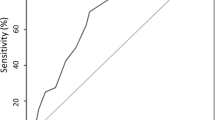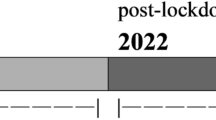Abstract
Previous studies reported high sensitivity and specificity of the Swiss Narcolepsy Scale (SNS) for the diagnosis of narcolepsy type 1. We used data from the Bern Sleep–Wake Database to investigate the discriminating capacity of both the SNS and the Epworth Sleepiness Scale (ESS) to identify narcolepsy type 1 and type 2 in patients with central disorders of hypersomnolence (CDH) or sleepy patients with obstructive sleep apnea (OSA). In addition, we aimed to develop a simplified version of the SNS. We created the two-item short-form SNS (sSNS), based on the discriminative capability of the models including all possible combinations of the five questions of the SNS. Using the previously published co-efficiencies, we confirmed the high capacity of the SNS in identifying narcolepsy type 1. The updated SNS (based on new co-efficiencies and cutoff) and the sSNS showed high capacity and were both superior to ESS in identifying narcolepsy type 1. The sSNS correlated significantly with the SNS (r = − 0.897, p < 0.001). No scale showed sufficient discrimination for narcolepsy type 2. This is the largest cohort study that confirms the discriminating power of SNS for narcolepsy type 1 in patients with hypersomnolence and the first study to assess its discriminative power for narcolepsy type 2. The easy-to-use and easy-to-calculate short-form scale has a high discriminating power for narcolepsy type 1 and may be used as screening tool, especially among general practitioners, to identify patients and accelerate their referral to a center of expertise.



Similar content being viewed by others
References
Scammell TE (2015) Narcolepsy. N Engl J Med 373(27):2654–2662. https://doi.org/10.1056/NEJMra1500587
Dauvilliers Y, Montplaisir J, Molinari N, Carlander B, Ondze B, Besset A, Billiard M (2001) Age at onset of narcolepsy in two large populations of patients in France and Quebec. Neurology 57(11):2029–2033
Ohayon MM, Ferini-Strambi L, Plazzi G, Smirne S, Castronovo V (2005) How age influences the expression of narcolepsy. J Psychosom Res 59(6):399–405. https://doi.org/10.1016/j.jpsychores.2005.06.065
Morrish E, King MA, Smith IE, Shneerson JM (2004) Factors associated with a delay in the diagnosis of narcolepsy. Sleep Med 5(1):37–41
Thorpy MJ (1992) The clinical use of the multiple sleep latency test. The standards of practice committee of the American Sleep Disorders Association. Sleep 15(3):268–276
Luca G, Haba-Rubio J, Dauvilliers Y, Lammers GJ, Overeem S, Donjacour CE, Mayer G, Javidi S, Iranzo A, Santamaria J, Peraita-Adrados R, Hor H, Kutalik Z, Plazzi G, Poli F, Pizza F, Arnulf I, Lecendreux M, Bassetti C, Mathis J, Heinzer R, Jennum P, Knudsen S, Geisler P, Wierzbicka A, Feketeova E, Pfister C, Khatami R, Baumann C, Tafti M, European Narcolepsy N (2013) Clinical, polysomnographic and genome-wide association analyses of narcolepsy with cataplexy: a European Narcolepsy Network study. J Sleep Res 22(5):482–495. https://doi.org/10.1111/jsr.12044
Hublin C, Kaprio J, Partinen M, Koskenvuo M, Heikkila K (1994) The Ullanlinna Narcolepsy Scale: validation of a measure of symptoms in the narcoleptic syndrome. J Sleep Res 3(1):52–59
Dauvilliers Y, Beziat S, Pesenti C, Lopez R, Barateau L, Carlander B, Luca G, Tafti M, Morin CM, Billiard M, Jaussent I (2017) Measurement of narcolepsy symptoms: the Narcolepsy Severity Scale. Neurology 88(14):1358–1365. https://doi.org/10.1212/WNL.0000000000003787
Hublin C, Kaprio J, Partinen M, Koskenvuo M, Heikkila K, Koskimies S, Guilleminault C (1994) The prevalence of narcolepsy: an epidemiological study of the Finnish Twin Cohort. Ann Neurol 35(6):709–716. https://doi.org/10.1002/ana.410350612
Johns MW (2000) Sensitivity and specificity of the multiple sleep latency test (MSLT), the maintenance of wakefulness test and the epworth sleepiness scale: failure of the MSLT as a gold standard. J Sleep Res 9(1):5–11
Wing YK, Li RH, Ho CK, Fong SY, Chow LY, Leung T (2000) A validity study of Ullanlinna Narcolepsy Scale in Hong Kong Chinese. J Psychosom Res 49(5):355–361
Sturzenegger C, Bassetti CL (2004) The clinical spectrum of narcolepsy with cataplexy: a reappraisal. J Sleep Res 13(4):395–406. https://doi.org/10.1111/j.1365-2869.2004.00422.x
Bloch KE, Schoch OD, Zhang JN, Russi EW (1999) German version of the Epworth Sleepiness Scale. Respiration 66(5):440–447. https://doi.org/10.1159/000029408
Vignatelli L, Plazzi G, Barbato A, Ferini-Strambi L, Manni R, Pompei F, D'Alessandro R (2003) Italian version of the Epworth Sleepiness Scale: external validity. Neurol Sci 23(6):295–300. https://doi.org/10.1007/s100720300004
Sturzenegger C, Baumann CR, Lammers GJ, Kallweit U, van der Zande WL, Bassetti CL (2018) Swiss Narcolepsy Scale: a simple screening tool for hypocretin-deficient narcolepsy with cataplexy. Clin Transl Neurosci 2(2):2514183X18794175
AASM (2007) Manual for the scoring of sleep and associated events: rules TaTS, 1st edn. American Academy of Sleep Medicine, Westchester
Trotti LM, Staab BA, Rye DB (2013) Test–retest reliability of the multiple sleep latency test in narcolepsy without cataplexy and idiopathic hypersomnia. JCSM 9(8):789–795. https://doi.org/10.5664/jcsm.2922
Acknowledgements
We thank Corinne Roth, Sandra Röthlisberger and Tanja Gerber for their assistance with the data transfer to the Bern Sleep–Wake Database. We also thank Christian Sturzenegger for the consultation.
Author information
Authors and Affiliations
Corresponding author
Ethics declarations
Conflicts of interest
The authors thank Jazz Pharmaceuticals for funding of this study. Jazz Pharmaceuticals also reviewed the manuscript and had the opportunity to provide suggestions to the authors for their consideration. Although Jazz Pharmaceuticals reviewed the content of this manuscript, the ultimate interpretation, and the decision to submit it for publication was made by the authors independently. “Jazz pharmaceuticals holds a royalty-bearing non-exclusive license to the SNS from the University of Bern”. Panagiotis Bargiotas has no specific conflict of interest with respect of present work. Dr. Bargiotas has received congress fees and travel reimbursements from Lundbeck Foundation. Anelia Dietmann, Marta Garcia Calle, Markus Schmidt, and Johannes Mathis have no specific conflict of interest with respect of present work and have nothing to declare. Alan G. Haynes is affiliated with CTU Bern, University of Bern, which has a staff policy of not accepting honoraria or consultancy fees. However, CTU Bern is involved in design, conduct, or analysis of clinical studies funded by not-for-profit and for-profit organizations. In particular, pharmaceutical and medical device companies provide direct funding to some of these studies. For an up-to-date list of CTU, Bern’s conflicts of interest see “https://www.ctu.unibe.ch/research/declaration_of_interest/index_eng.html”. Ulf Kallweit has received Honoraria for consultancy/advisory board and/or speaking engagements from: AOP Orphan Pharma; Bioprojet Pharma; Harmony Biosciences; Jazz Pharma; UCB Pharma. Claudio Bassetti has no specific conflict of interest with respect of present work. Prof. Bassetti has received honoraria for consultancy, lectures, and board memberships from the following institutions/companies: Jazz, Servier, UCB, Zambon, Cephalon Lundbeck, Pfizer Bohringer Ingelheim. His research is currently supported by grants of the following institutions/companies: Swiss National Science Foundation (SNF), ResMed, Respironics, Vifor Pharma, UCB Pharma, Schweizerische Herzstiftung, Tropos Stiftung, Parkinson Schweiz.
Electronic supplementary material
Below is the link to the electronic supplementary material.
Rights and permissions
About this article
Cite this article
Bargiotas, P., Dietmann, A., Haynes, A.G. et al. The Swiss Narcolepsy Scale (SNS) and its short form (sSNS) for the discrimination of narcolepsy in patients with hypersomnolence: a cohort study based on the Bern Sleep–Wake Database. J Neurol 266, 2137–2143 (2019). https://doi.org/10.1007/s00415-019-09365-2
Received:
Revised:
Accepted:
Published:
Issue Date:
DOI: https://doi.org/10.1007/s00415-019-09365-2




